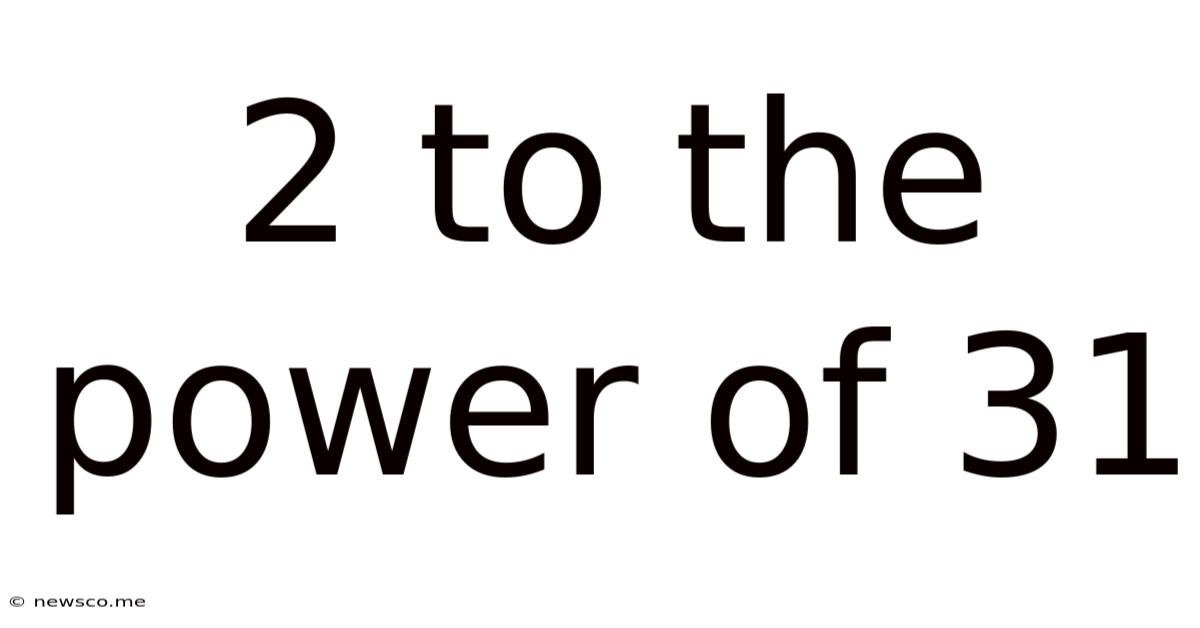2 To The Power Of 31
News Co
Mar 31, 2025 · 5 min read

Table of Contents
2 to the Power of 31: Exploring a Computational Milestone
2 to the power of 31, or 2<sup>31</sup>, is a seemingly simple mathematical expression, yet it holds significant weight in the world of computing and data representation. Understanding this number's magnitude and its implications is crucial for anyone working with binary systems, data structures, and the limitations of digital technologies. This comprehensive exploration delves into the calculation, significance, applications, and limitations associated with 2<sup>31</sup>.
Calculating 2 to the Power of 31
The calculation itself is straightforward: 2 multiplied by itself 31 times. However, the resulting number is far from trivial. Manually calculating this would be tedious, but thankfully, calculators and programming languages readily provide the answer: 2,147,483,648. This seemingly large number has profound consequences in the digital realm.
The Significance of 2<sup>31</sup> in Computing
The significance of 2<sup>31</sup> primarily stems from its close relationship to the 32-bit signed integer data type. In computer science, data types define the kind of information a variable can hold and the operations that can be performed on it. Signed integers allow for the representation of both positive and negative whole numbers. A 32-bit signed integer uses 32 binary digits (bits) to represent a number.
One bit is reserved for the sign (0 for positive, 1 for negative), leaving 31 bits for the magnitude of the number. The maximum positive value that can be represented using 31 bits is 2<sup>31</sup> - 1, or 2,147,483,647. Adding 1 to this maximum value results in an integer overflow, where the value wraps around to the minimum negative value, -2,147,483,648.
Understanding Integer Overflow
Integer overflow is a crucial concept. It's a common programming error that can lead to unexpected and potentially catastrophic results. When a program attempts to store a value larger than the maximum value allowed by the data type, the result "overflows" and becomes a completely different (and often incorrect) number. Consider a simple example:
int maxInt = Integer.MAX_VALUE; // 2,147,483,647
int overflowResult = maxInt + 1; // Result: -2,147,483,648
This seemingly innocuous addition results in a negative number due to integer overflow. This highlights the critical importance of understanding the limitations imposed by 2<sup>31</sup> in 32-bit systems.
Applications and Implications of 2<sup>31</sup>
The implications of 2<sup>31</sup> extend across various aspects of computing:
1. Data Storage and Representation
Understanding 2<sup>31</sup> is vital when working with data structures that rely on 32-bit integers. For instance, databases often use 32-bit integers as primary keys, limiting the maximum number of records to just under 2.15 billion. Exceeding this limit necessitates switching to a larger data type, such as 64-bit integers.
2. Game Development and Simulations
In video games and simulations, 2<sup>31</sup> often defines boundaries. For example, the maximum score, number of objects in a game world, or coordinates within a game engine might be limited by this value. Careful consideration of these limitations is crucial during the design and development phases.
3. Network Protocols and Addressing
Network protocols sometimes utilize 32-bit integers for addressing and identification. IPv4 addresses, for instance, are 32-bit numbers, although this limitation is largely overcome by the newer IPv6 protocol.
4. Image and Video Processing
In image and video processing, color representations and pixel coordinates might use 32-bit integers. Understanding the maximum values representable within this range is essential for proper image and video manipulation and display.
Moving Beyond 2<sup>31</sup>: The Rise of 64-bit Systems
The limitations imposed by 2<sup>31</sup> have driven the adoption of 64-bit systems, which can represent significantly larger numbers. A 64-bit signed integer can hold values up to 2<sup>63</sup> - 1, or approximately 9.22 x 10<sup>18</sup>. This vastly expands the range of data that can be processed and stored, effectively eliminating many of the overflow problems associated with 32-bit systems.
However, even with 64-bit systems, the fundamental concepts of data type limitations and potential for overflow remain relevant. While the risk is reduced, it's still possible to encounter overflow issues with particularly large datasets or complex calculations.
Practical Considerations and Best Practices
When working with integer data types, it's vital to:
- Choose the appropriate data type: Select the data type that best suits the expected range of values. Don't unnecessarily use large data types, as this can impact memory usage and performance.
- Perform range checks: Before performing calculations, check if the resulting value is within the acceptable range for the data type. This helps prevent unexpected overflow errors.
- Use exception handling: Incorporate exception handling mechanisms into your code to gracefully handle potential overflow scenarios.
- Consider alternative data structures: For extremely large datasets or calculations, consider using specialized data structures or libraries designed to handle numbers beyond the capacity of standard integer types.
Conclusion: The Enduring Relevance of 2<sup>31</sup>
Despite the widespread adoption of 64-bit systems, 2<sup>31</sup> remains a crucial number in computing. Understanding its significance, limitations, and implications is vital for programmers, software engineers, database administrators, and anyone working with digital systems. By recognizing the potential for integer overflow and implementing appropriate safeguards, developers can create robust and reliable software that avoids these potentially problematic scenarios. The knowledge of 2<sup>31</sup> serves as a constant reminder of the inherent limitations of digital representations and the need for careful planning and programming. It underlines the importance of understanding the underlying architecture of the systems we build and the data they manipulate. Finally, the evolution from 32-bit to 64-bit systems perfectly illustrates the iterative nature of technological advancement, constantly pushing boundaries and addressing limitations, while fundamental concepts remain consistently relevant.
Latest Posts
Related Post
Thank you for visiting our website which covers about 2 To The Power Of 31 . We hope the information provided has been useful to you. Feel free to contact us if you have any questions or need further assistance. See you next time and don't miss to bookmark.